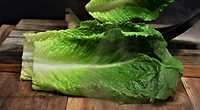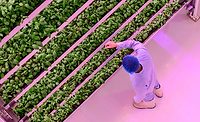FDA publishes report with key investigation findings from 2019 outbreaks associated with leafy greens

Today, the U.S. Food and Drug Administration published the findings of an investigation into the contamination of romaine lettuce implicated in three outbreaks of E. coli O157:H7 during the Fall of 2019.
Late last year the FDA, the Centers for Disease Control and Prevention and state partners investigated the contamination of romaine lettuce with several strains of E. coli O157:H7 that resulted in three outbreaks of foodborne illness traced back to the Salinas Valley growing region in California. These outbreaks—two multi-state and one single-state beginning in September and ending in December 2019—collectively resulted in 188 people falling ill.
The investigation was conducted at several farms identified in the outbreak traceback, as well as at other businesses and public access areas and resulted in several key findings:
- Each of these three outbreaks, identified in the report as Outbreaks A, B and C was caused by distinctly different strains of E. coli O157:H7 as determined by whole genome sequencing (WGS) analysis;
- Traceback investigations of multiple illness sub-clusters and supply chain information identified a common grower with multiple ranches/fields which supplied romaine lettuce during the timeframe of interest to multiple business entities associated with all three outbreaks.
- The same strain of E. coli O157:H7 that caused Outbreak A was found in two different brands of fresh-cut salads containing romaine lettuce in 2019;
- This same outbreak strain of E. coli O157:H7 in Outbreak A was detected in a fecal--soil composite sample taken from a cattle grate on public land less than two miles upslope from a produce farm with multiple fields tied to the outbreaks by the traceback investigations;
- Other strains of Shiga toxin-producing E.coli (STEC), while not linked to any of the outbreaks, were found in closer proximity to where romaine lettuce crops were grown, including two samples from a border area of a farm immediately next to cattle grazing land in the hills above leafy greens fields and two samples from on-farm water drainage basins.
The FDA considers adjacent or nearby land use for cattle grazing as the most likely contributing factor associated with these three outbreaks. While the agency could not confirm a definitive source or route(s) of contamination of the romaine fields, the agency considers indirect transmission of fecal material from adjacent and nearby lands from water run-off, wind, animals or vehicles to the romaine fields, or to the agricultural water sources used to grow the romaine, as possible routes of contamination.
These findings, together with the findings from earlier leafy greens outbreaks, suggest that a potential contributing factor has been the proximity of cattle—a persistent source of E. coli O157:H7 and other STEC—to the produce fields identified in traceback investigations. These key findings reinforce our concern about the possible impacts of nearby and adjacent land use on the safety of leafy green crops and further underscore the importance of implementing appropriate risk-based preventive measures to reduce the potential for contamination of leafy greens.
Because of the reoccurring nature of outbreaks associated with leafy greens, the FDA recently released a 2020 Leafy Greens STEC Action Plan, which outlines a three-pronged approach for tackling this problem. It describes the FDA’s plans for working with industry, federal partners, state and local regulators, academia and others to address the safety of leafy greens by advancing work in three areas: prevention, response, and addressing knowledge gaps.
Food safety is a shared responsibility that involves food producers, distributors, manufacturers, retailers, and regulators. FDA is committed to working with these stakeholders to implement this action plan to ensure that America’s food supply remains among the safest in the world.
For more information:
- Factors Potentially Contributing to the Contamination of Romaine Lettuce Implicated in the Three Outbreaks of E. coli O157:H7 During the Fall of 2019
- 2020 Leafy Greens STEC Action Plan
- FDA Outlines 2020 Action Plan to Help Advance the Safety of Leafy Greens
- Outbreak Investigation of E.coli: Romaine from Salinas, California (November 2019)
- Outbreak Investigation of E.coli: Salad Mix (December 2019)
Looking for a reprint of this article?
From high-res PDFs to custom plaques, order your copy today!








